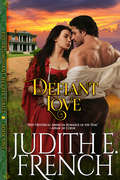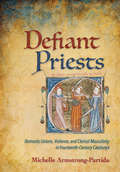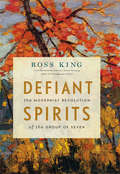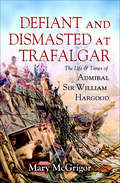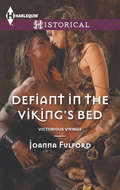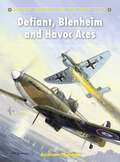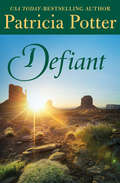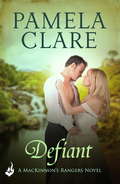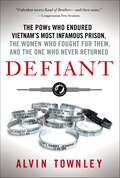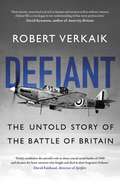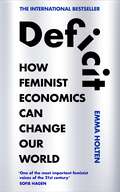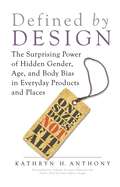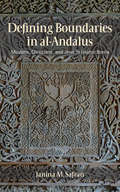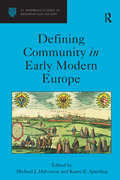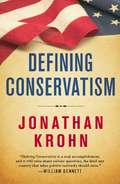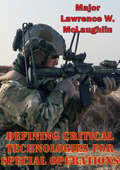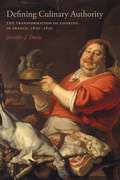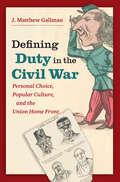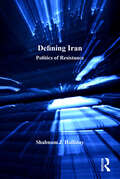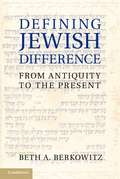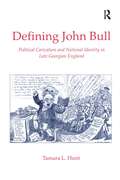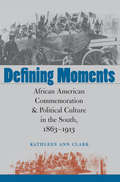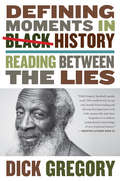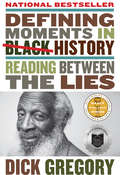- Table View
- List View
Defiant Love (The Triumphant Hearts Series #1)
by Judith E. FrenchIn her heart, Rebecca Bradford is no longer the orphaned white daughter of a wealthy Maryland planter; she is Star Blanket, a bold young woman with no need for fancy clothes or manners, and no understanding of the 'honor' that prohibits Adam Rourke from acting upon the desire raging in his dark eyes.Once a bondservant, Adam Rourke promised Rebecca's grandfather he would keep her safe until she assumed her role, and the fortune that was promised him.But Rebecca wishes to return to her adopted Shawnee, unable to become the person she no longer is.Granting Rebecca her freedom, guarantees Adam his fortune. But letting her go will cost him his heart.TRIUMPHANT HEARTS SERIES, in orderDefiant LoveTender FortuneBold SurrenderBy Love AloneAWARDS:Career Achievement Award for American Historicals, Romantic Times
Defiant Priests: Domestic Unions, Violence, and Clerical Masculinity in Fourteenth-Century Catalunya
by Michelle Armstrong-PartidaTwo hundred years after canon law prohibited clerical marriage, parish priests in the late medieval period continued to form unions with women that were marriage all but in name. In Defiant Priests, Michelle Armstrong-Partida uses evidence from extraordinary archives in four Catalan dioceses to show that maintaining a family with a domestic partner was not only a custom entrenched in Catalan clerical culture but also an essential component of priestly masculine identity.From unpublished episcopal visitation records and internal diocesan documents (including notarial registers, bishops' letters, dispensations for illegitimate birth, and episcopal court records), Armstrong-Partida reconstructs the personal lives and careers of Catalan parish priests to better understand the professional identity and masculinity of churchmen who made up the proletariat of the largest institution across Europe. These untapped sources reveal the extent to which parish clergy were embedded in their communities, particularly their kinship ties to villagers and their often contentious interactions with male parishioners and clerical colleagues. Defiant Priests highlights a clerical culture that embraced violence to resolve disputes and seek revenge, to intimidate other men, and to maintain their status and authority in the community.
Defiant Spirits
by Ross KingBeginning in 1912, Defiant Spirits traces the artistic development of Tom Thomson and the future members of the Group of Seven, Franklin Carmichael, Lawren Harris, A. Y. Jackson, Franz Johnston, Arthur Lismer, J. E. H. MacDonald, and Frederick Varley, over a dozen years in Canadian history. Working in an eclectic and sometimes controversial blend of modernist styles, they produced what an English critic celebrated in the 1920s as the "most vital group of paintings" of the 20th century. Inspired by Cézanne, Van Gogh and other modernist artists, they tried to interpret the Ontario landscape in light of the strategies of the international avant-garde. Based after 1914 in the purpose-built Studio Building for Canadian Art, the young artists embarked on what Lawren Harris called "an all-engrossing adventure": travelling north into the anadian Shield and forging a style of painting appropriate to what they regarded as the unique features of Canada's northern landscape.Rigorously researched and drawn from archival documents and letters, Defiant Spirits constitutes a "group biography," reconstructing the men's aspirations, frustrations and achievements. It details not only the lives of Tom Thomson and the members of the Group of Seven but also the political and social history of Canada
Defiant and Dismasted at Trafalgar: The Life & Times of Admiral Sir William Hargood
by Mary McGrigorBorn in 1762, William Hargood's naval career spanned over 30 years, as he rose from humble midshipman to the captain of one of the most powerful warships of the day at Trafalgar. He campaigned all over the known world: the Americas, West Indies, throughout the Mediterranean. Britain was hardly ever at peace during those troubled times and men like Hargood sought out her enemies wherever they could find them. This is the age of gold bullion, pirates, plunder and grapeshot.During his career Hargood became a close friend of Admiral Lord Nelson and shared many an experience and triumph with him.Hargood's Belleisle was dismasted in the thick of action at Trafalgar but never sunk.
Defiant in the Viking's Bed
by Joanna FulfordConsumed by revenge-and desire! Captured by his enemy and chained like a dog, Leif Egilsson has one thought in his mind: revenge. He'll no longer be beguiled by the treacherous beauty of Lady Astrid, and her innocence, which he so craved, will finally be his. On his escape, this fierce, proud Viking is bent on making her pay the price of her betrayal-in his bed! Only, Astrid has the heart of a warrior, and she will not be tamed as easily as he believes.... Victorious Vikings No man could defeat them. Three women would defy them!
Defiant, Blenheim and Havoc Aces
by Chris Davey Andrew ThomasThe World War 1 concept of the two-seat fighter persisted during the interwar period, with the RAF's biplane Demons being replaced by the twin-engined Blenheim IF - a fighter derivative of the light bomber then in service. By the start of World War 2 four regular and three Auxiliary squadrons of Fighter Command flew them, although very soon over a dozen more received them, albeit some used the Blenheim as interim equipment. The Blenheim IF flew some of Fighter Command's early offensive operations, and the type soon proved vulnerable when pitted against single-seat fighters. However, for much of 1940 the Blenheim fighter squadrons provided the RAF's main long-range convoy escort and nightfighter capability. Indeed it was a Blenheim that achieved the first night victory using then secret airborne radar, and many of the RAF's leading nightfighter aces were to learn their craft when flying the type. In the mid-1930s, in an attempt to capitalise on its expertise in power-operated gun turrets, the Boulton Paul company developed the Defiant, a single-engined fighter in which all the armament was concentrated in the turret behind the pilot. Intended as a 'bomber destroyer', the Defiant had its combat debut over Dunkirk, and initially achieved some considerable success. It sustained heavy losses when confronted by single-seat fighters, however. Later, with the Battle of Britain at its height, the two Defiant squadrons were deployed to southeast England, where, in spite of some early victories, they sustained crippling losses. These units, joined by a further ten squadrons, were then switched to nightfighter work, and achieved considerable success in holding the line through the night Blitz. The last examples were not finally withdrawn from frontline units until 1942. The fall of France saw an increasing number of American-built aircraft that had been ordered by the French government flown to Britain, including large numbers of Douglas DB-7 light bombers. Named Havoc by the RAF, some were fitted with radar for nightfighter duties and others replaced the Blenheim as night intruders. They proved successful in both roles. Less successfully, Havocs were also modified to mount an airborne searchlight to illuminate enemy bombers whilst others were employed as airborne minelayers to lay parachute mines ahead of enemy bombers. A total of 11 pilots claimed five or more victories when flying these three types to become aces, whilst no fewer than became 33 more aces claimed at least part of their scores when flying the Blenheim, Defiant or Havoc. More than 100 further aces also flew them, often honing and developing their skills before moving onto more efficacious nightfighters such as the Mosquito or Beaufighter.
Defiant: Diablo, Defiant, And Wanted
by Patricia PotterPost–Civil War Texas is the setting for this spellbinding story of a desperado out for vengeance and the woman determined to save his life Bequeathed a five-hundred-acre cattle ranch in Cimarron Valley, Mary Jo Williams takes her young son and strikes out for Colorado territory. The plucky widow has seen her share of sorrow, so when she finds a gravely wounded stranger, she&’s determined to nurse him back to health, unaware that Wade Foster never intended to make it out alive. A hunted outlaw with a price on his head, Wade spent years tracking down the murderers who massacred his family. Now a brutal shootout has made vengeance his at last. Prepared to confront his fate, he once again cheats death. He never expected his future to rest with an auburn-haired beauty and her boy. Sworn to protect mother and son, Wade has to stay one step ahead of the law—and a gang of ruthless killers. But as the net closes in, he knows the only way to keep them safe is to leave and never look back . . . unless he can find a way to put his past to rest.
Defiant: MacKinnon's Rangers 3 (MacKinnon's Rangers)
by Pamela ClarePamela Clare brings her expert plotting, sizzling chemistry and thrilling adventure to her sweeping MacKinnon's Rangers series, in the grand tradition of The Last of the Mohicans, perfect for fans of Maya Banks, Monica McCarty and Zoe Archer.They were a band of brothers, their loyalty to one another forged by hardship and battle, the bond between these Highland warriors, rugged colonials, and fierce Native Americans stronger even than blood ties.Major Connor MacKinnon despises his commander, Lord William Wentworth, beyond all other men. Ordered to rescue Wentworth's niece after the Shawnee take her captive, he expects Lady Sarah Woodville to be every bit as contemptible as her uncle. Instead, he finds a brave and beautiful lass in desperate peril. But the only way to free Sarah is for Connor to defeat the Shawnee warrior who kidnapped her - and claim her himself.Torn by tragedy from her sheltered life in London, Lady Sarah is unprepared for the harshness of the frontier - or for the attraction she feels toward Connor. When they reach civilization, however, it is she who must protect him. For if her uncle knew all that Connor had done to save her, he would surely kill him. But the flames of passion, once kindled, are difficult to deny. As desire transforms into love, Connor will have to defy an empire to keep Sarah at his side.Be swept away by the other sexy MacKinnon's Rangers in Surrender and Untamed. Or take a wildly romantic ride with Pamela Clare's I-Team: Extreme Exposure, Hard Evidence, Unlawful Contact, Naked Edge, Breaking Point, Striking Distance, Seduction Game.
Defiant: The POWs Who Endured Vietnam's Most Infamous Prison, The Women Who Fought for Them, and The One Who Never Returned
by Alvin Townley50 years ago, the POWs who endured Vietnam's most famous prison came home. A powerful story of survival and triumph. Alvin Townley's Defiant will inspire anyone wondering how courage, faith, and brotherhood can endure even in the darkest of situations. “A riveting tribute to true American heroes.”—Senator John McCain, POW (1967-73)"Defiant is Unbroken meets Band of Brothers—and then some." —Congressman Pete SessionsDuring the Vietnam War, hundreds of American prisoners-of-war faced years of brutal conditions and horrific torture at the hands of North Vietnamese guards and interrogators who ruthlessly plied them for military intelligence and propaganda. Determined to maintain their Code of Conduct, the POWs developed a powerful underground resistance. To quash it, their captors singled out its eleven leaders, Vietnam's own "dirty dozen," and banished them to an isolated jail that would become known as Alcatraz. None would leave its solitary cells and interrogation rooms unscathed; one would never return.As these eleven men suffered in Hanoi, their wives at home launched an extraordinary campaign that would ultimately spark the nationwide POW/MIA movement. The members of these military families banded together and showed the courage not only to endure years of doubt about the fate of their husbands and fathers, but to bravely fight for their safe return. When the survivors of Alcatraz finally came home in 1973, one veteran would go on to receive the Medal of Honor, another would become a U.S. Senator, and a third served in the U.S. Congress.
Defiant: The Untold Story of the Battle of Britain
by Robert Verkaik'Defiant is both a stirring testament to the courage of the men who flew them and a welcome new examination of one of the Second World War's most famous conflicts'Alexander Larman, ObserverIn this startling new perspective on the Battle of Britain, Robert Verkaik reveals the surprising truth about the battle's forgotten fighter, the Boulton Paul Defiant.The crucial role played by the Spitfire and the Hurricane has been exhaustively recorded, but, to date, next to nothing has been written about the third British fighter which took part in the battle. By writing from the unique perspective of the pilots who flew the Defiant and their air-gunners, Verkaik helps to set the record straight. The Air Staff regarded the Defiant as a state-of-the-art bomber destroyer and wanted to equip a third of all Fighter Command squadrons with this new plane. But the head of Fighter Command, Hugh Dowding, had other ideas and went to war with Whitehall over its plan to saddle him with hundreds of 'obsolete' turret fighters. Then at Dunkirk, a Defiant squadron scored a huge success against the Luftwaffe by shooting down more German planes in one day than any other RAF unit before or since. Fighter Command, enthusiastically urged on by the Air Ministry, now committed its third fighter to the coming air battle over southern England. In the desperate dogfights of the battle, Defiants shot down both German bombers and fighters but suffered heavy losses too - one squadron was almost wiped out when it was ambushed by a superior force of Messerschmitt 109s. On 30 August 1940 all Defiant squadrons were withdrawn from the front line. The families of the Defiant air crews believed that their husbands, brothers and sons had died in vain, but the truth is that their vital contribution to the battle over Dunkirk and their role in the Battle of Britain has been all but erased from the official history. The story of the Defiant has not been allowed to mar the glorious victory won by the Spitfire and the Hurricane.But Verkaik has uncovered new records, including top-secret memos written by Hugh Dowding and his deputy Keith Park as well as correspondence with the Air Staff, combat and squadron reports, pilot logs and recordings of the last interviews with Defiant crews. He has also succeeded in tracing relatives of Defiant pilots and gunners to tell the story of the Battle of Britain as it has never been told before. He reveals how the myths which have grown up around the Defiant mask some inconvenient truths.
Deficit: How Feminist Economics Can Change Our World
by Emma Holten*AN INTERNATIONAL BESTSELLER*WINNER OF THE POLITIKEN LITERATURE PRIZE 2024'Brilliantly rewrites the history of economic thought to place 'her story' at its heart. A must-read' - Kate Raworth, author of DOUGHNUT ECONOMICS'One of the most important feminist voices of the 21st century . . . The book about capitalism we didn't know we needed' - Sofie HagenIn 2020, the prominent Danish feminist Emma Holten read an article stating that women were a net ‘deficit’ to society. Women took more than they gave, ‘draining’ the public purse by giving birth and taking parental leave. They contributed less than their fair share in taxes, because they often worked part-time to look after other people at home, or held low-paidjobs in the public sector. Denmark would be richer if women’s lives looked more like men’s, the economic experts concluded. A similar story is told around the globe.How did we get here? In Deficit, Emma Holten traces how economic thinkers – from the Enlightenment onwards – created a value framework that overlooked and neglected ‘women’s work’ and acts of care. She reveals how the economic models that drive political decisions today are just as flawed, giving us unparalleled monetary wealth, but causing deep social harms that are hurting us all.If we cannot properly value the things that matter, how can we build a better future?
Defined by Design: The Surprising Power of Hidden Gender, Age, and Body Bias in Everyday Products and Places
by Kathryn H. AnthonyThis wide-ranging overview of design in everyday life demonstrates how design shapes our lives in ways most of us would never imagine. The author, a leading expert in social and psychological issues in design, uncovers the gender, age, and body biases inherent in the designs of common products and living spaces that we all routinely use. From the schools our children attend and the buildings we work in to ill-fitting clothes and one-size-fits-all seating in public transportation, restaurants, and movie theaters, we are surrounded by an artificial environment that can affect our comfort, our self-image, and even our health.Anthony points out the flaws and disadvantages of certain fashions, children's toys, high-tech gadgets, packaging, public transportation, public restrooms, neighborhood layouts, classrooms, workplaces, hospitals, and more. In an increasingly diverse populace where many body types, age groups, and cultures interact, she argues that it's time our environments caught up. This fascinating book--full of aha moments--will teach readers to recognize the hidden biases in certain products and places and to work for more intelligent and healthy design in all areas of life.
Defining Boundaries in al-Andalus: Muslims, Christians, and Jews in Islamic Iberia
by Janina M. SafranAl-Andalus, the Arabic name for the medieval Islamic state in Iberia, endured for over 750 years following the Arab and Berber conquest of Hispania in 711. While the popular perception of al-Andalus is that of a land of religious tolerance and cultural cooperation, the fact is that we know relatively little about how Muslims governed Christians and Jews in al-Andalus and about social relations among Muslims, Christians, and Jews. In Defining Boundaries in al-Andalus, Janina M. Safran takes a close look at the structure and practice of Muslim political and legal-religious authority and offers a rare look at intercommunal life in Iberia during the first three centuries of Islamic rule.Safran makes creative use of a body of evidence that until now has gone largely untapped by historians-the writings and opinions of Andalusi and Maghribi jurists during the Umayyad dynasty. These sources enable her to bring to life a society undergoing dramatic transformation. Obvious differences between conquerors and conquered and Muslims and non-Muslims became blurred over time by transculturation, intermarriage, and conversion. Safran examines ample evidence of intimate contact between individuals of different religious communities and of legal-juridical accommodation to develop an argument about how legal-religious authorities interpreted the social contract between the Muslim regime and the Christian and Jewish populations. Providing a variety of examples of boundary-testing and negotiation and bringing judges, jurists, and their legal opinions and texts into the narrative of Andalusi history, Safran deepens our understanding of the politics of Umayyad rule, makes Islamic law tangibly social, and renders intercommunal relations vividly personal.
Defining Community in Early Modern Europe (St Andrews Studies in Reformation History)
by Michael J. HalvorsonNumerous historical studies use the term "community'" to express or comment on social relationships within geographic, religious, political, social, or literary settings, yet this volume is the first systematic attempt to collect together important examples of this varied work in order to draw comparisons and conclusions about the definition of community across early modern Europe. Offering a variety of historical and theoretical approaches, the sixteen original essays in this collection survey major regions of Western Europe, including France, Geneva, the German Lands, Italy and the Spanish Empire, the Netherlands, England, and Scotland. Complementing the regional diversity is a broad spectrum of religious confessions: Roman Catholic communities in France, Italy, and Germany; Reformed churches in France, Geneva, and Scotland; Lutheran communities in Germany; Mennonites in Germany and the Netherlands; English Anglicans; Jews in Germany, Italy, and the Netherlands; and Muslim converts returning to Christian England. This volume illuminates the variety of ways in which communities were defined and operated across early modern Europe: as imposed by community leaders or negotiated across society; as defined by belief, behavior, and memory; as marked by rigid boundaries and conflict or by flexibility and change; as shaped by art, ritual, charity, or devotional practices; and as characterized by the contending or overlapping boundaries of family, religion, and politics. Taken together, these chapters demonstrate the complex and changeable nature of community in an era more often characterized as a time of stark certainties and inflexibility. As a result, the volume contributes a vital resource to the ongoing efforts of scholars to understand the creation and perpetuation of communities and the significance of community definition for early modern Europeans.
Defining Conservatism
by Jonathan KrohnDefining Conservatismis a passionate appeal to a political movement that is re-examining its identity as Republicans set their sights on 2010 and beyond. A dedicated young conservative, Jonathan Krohn presents conservative philoso¬phy’s basic tenets in this remarkably earnest and impeccably reasoned primer. This book, clear and informative, is a history lesson, a manifesto, and a roadmap for the future. It is Krohn’s rallying call to action not just for conservatives, but for anyone interested in the political state of our nation. InDefining Conservatism, Krohn challenges “government expansionists,” whose faith in Wash¬ington and the basic pillars of government exceeds their faith in the individual. At the same time, he boldly stakes out four unshakeable principles for conservatives to rally around: ? Respect for the Constitution ? Respect for human life ? Belief in minimalist government ? Insistence upon personal responsibility Anyone interested in the basic differences between conservative and liberal thought will find Krohn’s writing at once compelling, informa¬tive, intelligent, and—for those who do not agree with him—in some respects controversial. Defining Conservatismis a must-read for anyone who is interested in the basic principles upon which the United States was founded, and perhaps most importantly, for anyone who is concerned with the future of this country.
Defining Conservatism
by Jonathan KrohnA dedicated young Conservative, Jonathan Krohn presents Conservative philosophy's basic tenets in this remarkably earnest and impeccably reasoned primer. This book, clear and informative, is a history lesson, a manifesto, and a roadmap for the future.Anyone interested in the basic differences between Conservative and Liberal thought will find Krohn's writing at once compelling, informative, intelligent, and--for those who do not agree with him--in some respects controversial.
Defining Critical Technologies For Special Operations
by Major Lawrence W. McLaughlinAs the military forces of the United States continue to draw down, Special Operations Forces (SOF) are playing a greater role across the entire spectrum of conflict. In order to maintain its relative advantage, SOF is using technology as a means to leverage limited resources--sometimes to the point that mission accomplishment depends critically on a technology's availability. Adversaries will attempt to challenge our advantages. Whether Special Operations Forces are prepared to operate in a degraded environment could determine success or failure.This thesis examines the issue of critical technologies in special operations. Critical technologies are defined according to three variables--level of dependence, degree of vulnerability, and substitutability. By examining technologies against these three variables, SOF can gain a better understanding of the impact to SOF operations if a technical capability is lost. Three technologies are examined to illustrate the model--the use of Radar in the Battle of Britain, the Global Positioning System, and UHF Satellite Communications.By applying the model to actual cases, I hope to encourage SOF decision-makers to closely examine our growing reliance on vulnerable technologies as a force multiplier and provide recommendations to prevent undue reliance on those technologies.
Defining Culinary Authority: The Transformation of Cooking in France, 1650-1830
by Jennifer J. DavisIn the eighteenth and nineteenth centuries, French cooks began to claim central roles in defining and enforcing taste, as well as in educating their diners to changing standards. Tracing the transformation of culinary trades in France during the Revolutionary era, Jennifer J. Davis argues that the work of cultivating sensibility in food was not simply an elite matter; it was essential to the livelihood of thousands of men and women.Combining rigorous archival research with social history and cultural studies, Davis analyzes the development of cooking aesthetics and practices by examining the propagation of taste, the training of cooks, and the policing of the culinary marketplace in the name of safety and good taste. French cooks formed their profession through a series of debates intimately connected to broader Enlightenment controversies over education, cuisine, law, science, and service. Though cooks assumed prominence within the culinary public sphere, the unique literary genre of gastronomy replaced the Old Regime guild police in the wake of the French Revolution as individual diners began to rethink cooks' authority. The question of who wielded culinary influence -- and thus shaped standards of taste -- continued to reverberate throughout society into the early nineteenth century.This remarkable study illustrates how culinary discourse affected French national identity within the country and around the globe, where elite cuisine bears the imprint of the country's techniques and labor organization.
Defining Duty in the Civil War: Personal Choice, Popular Culture, and the Union Home Front (Civil War America)
by J. Matthew GallmanThe Civil War thrust Americans onto unfamiliar terrain, as two competing societies mobilized for four years of bloody conflict. Concerned Northerners turned to the print media for guidance on how to be good citizens in a war that hit close to home but was fought hundreds of miles away. They read novels, short stories, poems, songs, editorials, and newspaper stories. They laughed at cartoons and satirical essays. Their spirits were stirred in response to recruiting broadsides and patriotic envelopes. This massive cultural outpouring offered a path for ordinary Americans casting around for direction. Examining the breadth of Northern popular culture, J. Matthew Gallman offers a dramatic reconsideration of how the Union's civilians understood the meaning of duty and citizenship in wartime. Although a huge percentage of military-aged men served in the Union army, a larger group chose to stay home, even while they supported the war. This pathbreaking study investigates how men and women, both white and black, understood their roles in the People's Conflict. Wartime culture created humorous and angry stereotypes ridiculing the nation's cowards, crooks, and fools, while wrestling with the challenges faced by ordinary Americans. Gallman shows how thousands of authors, artists, and readers together created a new set of rules for navigating life in a nation at war.
Defining Iran: Politics of Resistance
by Shabnam J. HollidayDefining Iran presents a new and revealing analysis of the way in which Iranian political discourses compete with each other by examining them within the framework of national identity construction. By deconstructing the intellectual roots and development of Iranian national identity, Shabnam Holliday advocates the need to study Iran's heritage and historical experience to understand key shifts and processes in contemporary Iranian politics. Holliday convincingly argues that competing discourses of national identity advocated by political figures from Musaddiq to the current administration demonstrate a politics of resistance to both internal and external forces. With a particular emphasis on Khatami’s presidency, this study compares the meanings attached by significant members of the Iranian political elite to concepts including Iran’s pre-Islamic heritage, Islamic heritage, civilization, 'democracy' and the 'West'. Furthermore, discourses of Iranian national identity exist not in isolation but rather as part of a continuous process construction and reconstruction in Iran's journey of political development; a process manifested so vividly in the revolution of 1979 and the fallout from the 2009 presidential election. Defining Iran simultaneously furthers our understanding of the conceptualization of national identity both generally and specifically in the case of Iran and political dynamics which shape contemporary Iran.
Defining Jewish Difference: From Antiquity to the Present
by Beth A. BerkowitzThis book traces the interpretive career of Leviticus 18:3, a verse that forbids Israel from imitating its neighbors. Beth A. Berkowitz shows that ancient, medieval and modern exegesis of this verse provides an essential backdrop for today's conversations about Jewish assimilation and minority identity more generally. The story of Jewishness that this book tells may surprise many modern readers for whom religious identity revolves around ritual and worship. In Leviticus 18:3's story of Jewishness, sexual practice and cultural habits instead loom large. The readings in this book are on a micro-level, but their implications are far-ranging: Berkowitz transforms both our notion of Bible-reading and our sense of how Jews have defined Jewishness.
Defining John Bull: Political Caricature and National Identity in Late Georgian England
by Tamara L. HuntLate Georgian England was a period of great social and political change, yet whether this was for good or for ill was by no means clear to many Britons. In such an era of innovation and revolution, Britons faced the task of deciding which ideals, goals and attitudes most closely fitted their own conception of the nation for which they struggled and fought; the controversies of the era thus forced ordinary people to define an identity that they believed embodied the ideal of 'Britishness' to which they could adhere in this period of uncertainty. Defining John Bull demonstrates that caricature played a vital role in this redefinition of what it meant to be British. During the reign of George III, the public's increasing interest in political controversies meant that satirists turned their attention to the individuals and issues involved. Since this long reign was marked by political crises, both foreign and domestic, caricaturists responded with an outpouring of work that led the era to be called the 'golden age' of caricature. Thus, many and varied prints, produced in response to public demands and sensitive to public attitudes, provide more than simply a record of what interested Britons during the late Georgian era. In the face of domestic and foreign challenges that threatened to shake the very foundations of existing social and political structures, the public struggled to identify those ideals, qualities and characteristics that seemed to form the basis of British society and culture, and that were the bedrock upon which the British polity rested. During the course of this debate, the iconography used to depict it in graphic satire changed to reflect shifts in or the redefinition of existing ideals. Thus, caricature produced during the reign of George III came to visually express new concepts of Britishness.
Defining Moments
by Kathleen Ann ClarkThe historical memory of the Civil War and Reconstruction has earned increasing attention from scholars. Only recently, however, have historians begun to explore African American efforts to interpret those events. With Defining Moments, Kathleen Clark shines new light on African American commemorative traditions in the South, where events such as Emancipation Day and Fourth of July ceremonies served as opportunities for African Americans to assert their own understandings of slavery, the Civil War, and Emancipation--efforts that were vital to the struggles to define, assert, and defend African American freedom and citizenship.Focusing on urban celebrations that drew crowds from surrounding rural areas, Clark finds that commemorations served as critical forums for African Americans to define themselves collectively. As they struggled to assert their freedom and citizenship, African Americans wrestled with issues such as the content and meaning of black history, class-inflected ideas of respectability and progress, and gendered notions of citizenship. Clark's examination of the people and events that shaped complex struggles over public self-representation in African American communities brings new understanding of southern black political culture in the decades following Emancipation and provides a more complete picture of historical memory in the South.
Defining Moments in Black History: Reading Between the Lies
by Dick GregoryWith his trademark acerbic wit, incisive humor, and infectious paranoia, one of our foremost comedians and most politically engaged civil rights activists looks back at 100 key events from the complicated history of black America.A friend of luminaries including Dr. Martin Luther King, Jr. and Medgar Evers, and the forebear of today’s popular black comics, including Larry Wilmore, W. Kamau Bell, Damon Young, and Trevor Noah, Dick Gregory was a provocative and incisive cultural force for more than fifty years. As an entertainer, he always kept it indisputably real about race issues in America, fearlessly lacing laughter with hard truths. As a leading activist against injustice, he marched at Selma during the Civil Rights movement, organized student rallies to protest the Vietnam War; sat in at rallies for Native American and feminist rights; fought apartheid in South Africa; and participated in hunger strikes in support of Black Lives Matter. In this collection of thoughtful, provocative essays, Gregory charts the complex and often obscured history of the African American experience. In his unapologetically candid voice, he moves from African ancestry and surviving the Middle Passage to the creation of the Jheri Curl, the enjoyment of bacon and everything pig, the headline-making shootings of black men, and the Black Lives Matter movement. A captivating journey through time, Defining Moments in Black History explores historical movements such as The Great Migration and the Harlem Renaissance, as well as cultural touchstones such as Sidney Poitier winning the Best Actor Oscar for Lilies in the Field and Billie Holiday releasing Strange Fruit. An engaging look at black life that offers insightful commentary on the intricate history of the African American people, Defining Moments in Black History is an essential, no-holds-bar history lesson that will provoke, enlighten, and entertain.
Defining Moments in Black History: Reading Between the Lies
by Dick GregoryNAACP 2017 Image Award WinnerWith his trademark acerbic wit, incisive humor, and infectious paranoia, one of our foremost comedians and most politically engaged civil rights activists looks back at 100 key events from the complicated history of black America.A friend of luminaries including Dr. Martin Luther King, Jr. and Medgar Evers, and the forebear of today’s popular black comics, including Larry Wilmore, W. Kamau Bell, Damon Young, and Trevor Noah, Dick Gregory was a provocative and incisive cultural force for more than fifty years. As an entertainer, he always kept it indisputably real about race issues in America, fearlessly lacing laughter with hard truths. As a leading activist against injustice, he marched at Selma during the Civil Rights movement, organized student rallies to protest the Vietnam War; sat in at rallies for Native American and feminist rights; fought apartheid in South Africa; and participated in hunger strikes in support of Black Lives Matter. In this collection of thoughtful, provocative essays, Gregory charts the complex and often obscured history of the African American experience. In his unapologetically candid voice, he moves from African ancestry and surviving the Middle Passage to the creation of the Jheri Curl, the enjoyment of bacon and everything pig, the headline-making shootings of black men, and the Black Lives Matter movement. A captivating journey through time, Defining Moments in Black History explores historical movements such as The Great Migration and the Harlem Renaissance, as well as cultural touchstones such as Sidney Poitier winning the Best Actor Oscar for Lilies in the Field and Billie Holiday releasing Strange Fruit. An engaging look at black life that offers insightful commentary on the intricate history of the African American people, Defining Moments in Black History is an essential, no-holds-bar history lesson that will provoke, enlighten, and entertain.
